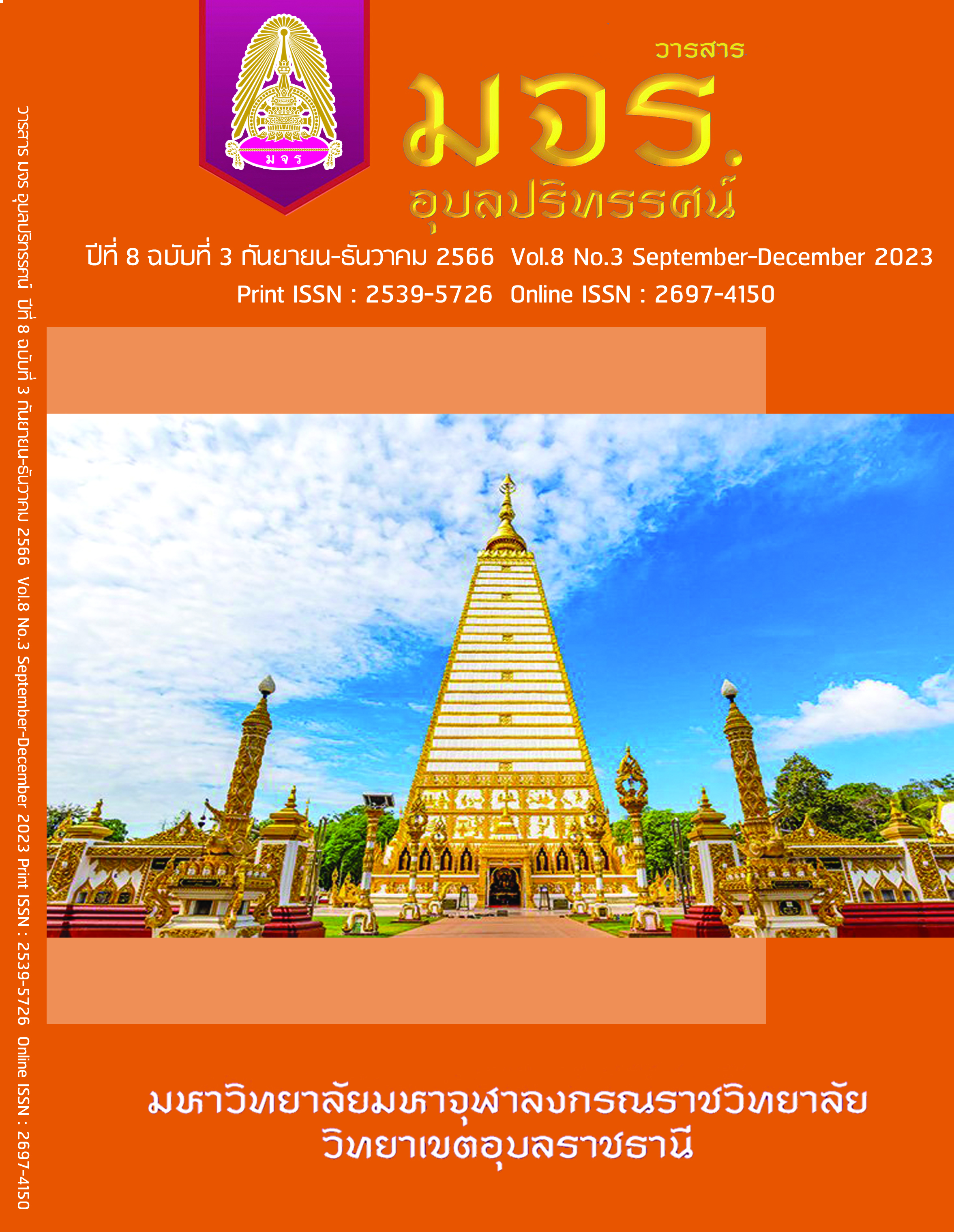การสำรวจแนวทางการพัฒนาการเรียนการสอนออนไลน์ที่ส่งผลต่อประสิทธิผลการสอนในโรงเรียนประถมศึกษา จังหวัดอุบลราชธานี
Main Article Content
บทคัดย่อ
งานวิจัยนี้มีวัตถุประสงค์เพื่อนำเสนอแนวทางการพัฒนาประสิทธิผลการสอนออนไลน์ ในสถานการณ์โควิด-19 ของโรงเรียนประถมศึกษา จังหวัดอุบลราชธานี โดยผู้วิจัยใช้แบบสอบถามจำนวน 29 ข้อไปรวบรวมความเห็นของผู้บริหารและครูจำนวน 242 คนแล้วนำกลับมาวิเคราะห์ผลด้วยโปรแกรมสำเร็จรูปทางสถิติ และมีผลวิจัยพบว่า แนวทางการพัฒนาประสิทธิผลการสอนแบบออนไลน์ ประกอบด้วย 3 แนวทางคือ 1) การพัฒนาตำแหน่งงานไปพร้อมกับการใช้ Facebook จัดการเรียนการสอนสำหรับครู 2) การพัฒนาความถี่ในการใช้สื่อออนไลน์กับการใช้ Google Zoom จัดกิจกรรมการเรียนและการสอน และ 3) การพัฒนาการใช้ Facebook กับ YouTube โดยทั้งสามแนวทางพัฒนาที่กล่าวถึงมีอิทธิพลต่อการทำนายประสิทธิผลการสอนออนไลน์ได้ที่สัมประสิทธิ์ R2 ที่ค่า .37, .48 และ .32 ตามลำดับ
Article Details
References
อรรถพลอนันตวรสกุล (2564).วิกฤติ! การศึกษาออนไลน์“ รัฐบาลเป็นหัวหอกแก้ปัญหา. หนังสือพิมพ์
เดลินิวส์, วันพฤหัสบดีที่ 18 มีนาคม 2564
Anderson, T., Rourke, L., Garrison, D.R., & Archer, W. (2001). Assessing teaching
presence in a computer conferencing context. Journal of Asynchronous Learning Networks,5 (2), 1 17.
Avasthi, Avijit, Effectiveness ofOnline E-Teaching among Dental Students during
COVID-19 A Study from North India.
Azmi, S., lahad, N. A., & Ahmad, N. (2015). Gamification in online collaborative
learning for programming courses: A literature review. ARPN Journal of Engineering and Applied Sciences, 10 (23), 18087- 18094.
Bolliger, D.U., &Wasilik, O. (2009). Factors influencing faculty satisfaction with online
teaching and learning in higher education. Distance Education, 30 (1), 103-116.
Boonchai, P. (2020). Learning management competency to develop 21st century
learners of elementary school teachers, Saint John's Journal,23(33), 240-258.
Burdina, M.G., Krapotkina, I. E., &Nasyrova, L. G. (2019). Distance Learning in
Elementary School Classrooms: An Emerging Framework for Contemporary Practice. International Journal of Instruction, 12 (1), 1-16.
https://doi.org/10.29333/iji.2019.1211
DeWey, J. (1933). How we think: A restatement of the relation of reflective thinking
to the educational process. Lexington, MA: Heath Publishing.
Dixson, M. D. (2010). Creating effective student engagement in online courses: What
dostudents find engaging ?. Journal of the Scholarship of Teaching and Learning, 1- 13.
Elliott, M., Rhoades, N., Jackson, C. M.., &Mandernach, B. J. (2015). Professional
development: Designing initiatives to meet the needs of online faculty. Journal of Educators Online, 12, 160–188.
Fakcharoenphol, W., Chaowatthanakun, K., Varasuwan, P., Nugultham, K.,
Laohammanee, K., Suwannaphicat, S., &Suwan, S. (2020). Readiness to implement online learning management under the covid-19 pandemics, Journal of Education and Human Development Science, 4(1), 44-61.
Lowenthal, P., & Hodges, C. (2015) search Using Quality Matters to analyze the
quality of massive, open, online courses (MOOCs). The International Review of Research Open and Distributed Learning,16 (5), 83-101.
Ornellas, A. & Romero, M. (2011).La planificacio col laborativa de la docenciaenlinia.
Retrievedfromhttp://cv.uoc.edu/annotation/20c490ecb89e4afb6f04f87b4c3b89c8/485129/PID 00178140/modul6.html#w26aac17b7
Oonsapiv, J. &Nunthachaiya, S. (2021). Problems and needs of learning management
during the covid-19 situation at WatdanSamrong school primary educational service area office Samutprakan district 1, Journal of Modern Learning Development,6(4), 49-66.
Manurung,R.T. (2021).Effectiveness and efficiency teaching and learning process with
course learningsystem. IikogeretimOnline-Elementary Education, 20(4), 1141-1146 http://ilkogretim-online.org doi:1017051/ilkonline.2021.04.127
Manwaring, K. C. , Larsen, R. , Graham, C. R. , &Henrie, C. R. , & Halverson, L. R. 2017).
Investigating student engagement in blended learning setting using experience sampling and structural equation modeling. Journal of Internet and Higher Education, 4 (1).145-184.
Mishra, P., & Koehler, M.J. (2006). Technological pedagogical content knowledge: A
framework for teacher knowledge. Teachers College Record, 108(6), 1017–
Moate, R. M., & Cox, J. A. (2015). Learner-centered pedagogy: Consideration for
applications in a didactic course. Professional Counselor, 5(3), 379-389.
Morphew, V. N. (2002). Web-based learning and instruction: A constructivist approach.
In Web based instructional learning (pp. 1-14). IGI Global.
Nortvig, A. M. , Petersen, A. K. , &Balle, S. H. (2018). A literature review of the factors
influencing e-learning and blended learning in relation to learning outcome, student. Electronic Journal of e-Learning, 16 (1), 46-55.
Rathachatranon, W. (2019). Determining an appropriate sample size for social science
research: the myth of using Taro Yamane and Krejcie& Morgan method, Political Science Preview,6(1), 26-58.
Rajab, K. D. (2018). The effectiveness and potential of E-learning in war zones:
Anempiricalcomparison of fasce-face and onlinebeducation in Saudi Arabia. IEEE ACCESS, 6, 6783-6794.
Robinson, C. C. ,&Hullinger, H. (2008). New benchmarks in higher education: Student
engagement in online learning. Journal of Education for Business, 84 (2), 101-109.
Sawannamat, A. (2020). Model of learning management in the 21st century by using
social media to raise the achievement of students in schools under the Sukhothai
primary educational service area official, Journal of Education Administration, KhonKaen University, 16(2), 93-107.
Sudjana, N. & Ibrahim. (2004). Educational Research Assessment. Bandung: SinarBaru.
Uppal, M. A. , Ali, S. , & Gulliver, S. R. (2018). Factors determining e-learning service
quality. British Journal of Educational Technology, 49 (3), 412-426.
Zhang, J., & Zhang, J. (2009) “Influencing of online learning and the LICE
model.” e-Education Research 194(6): 73-77.

